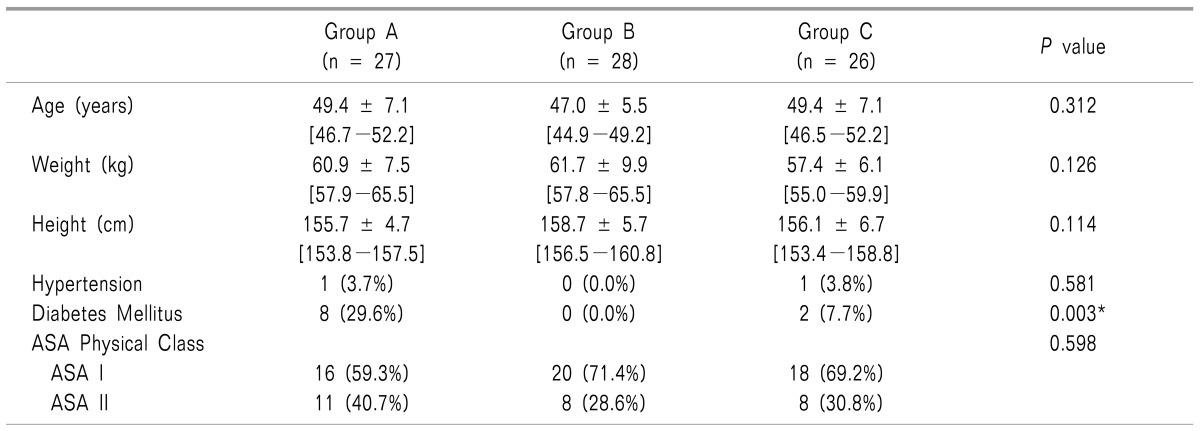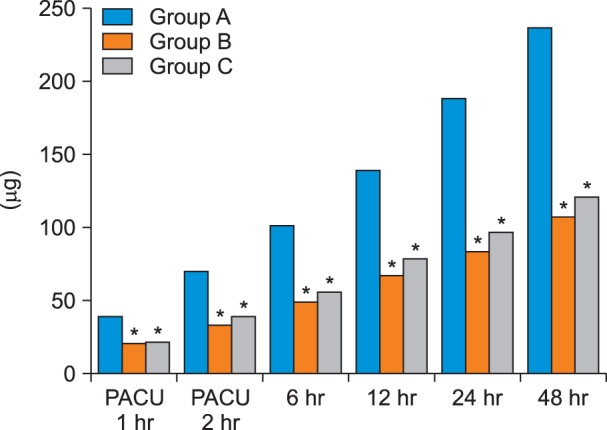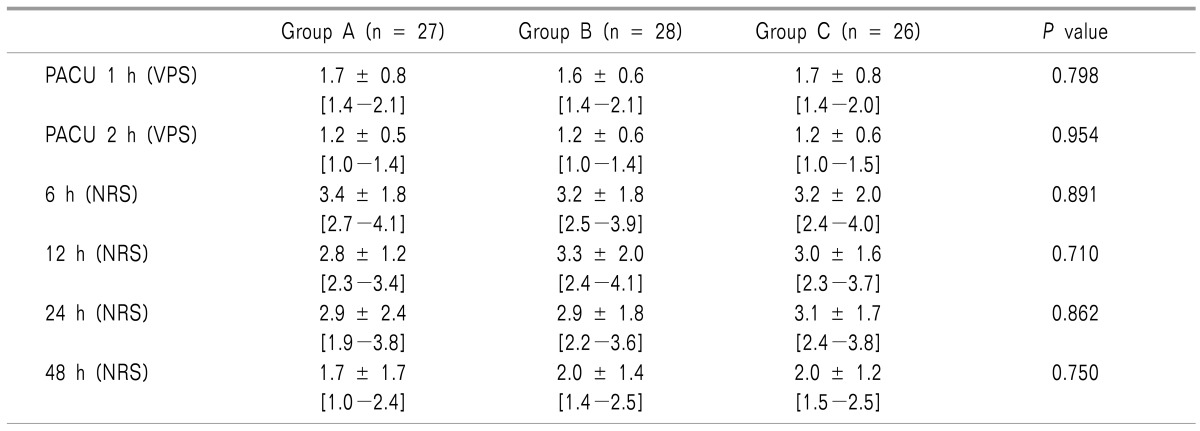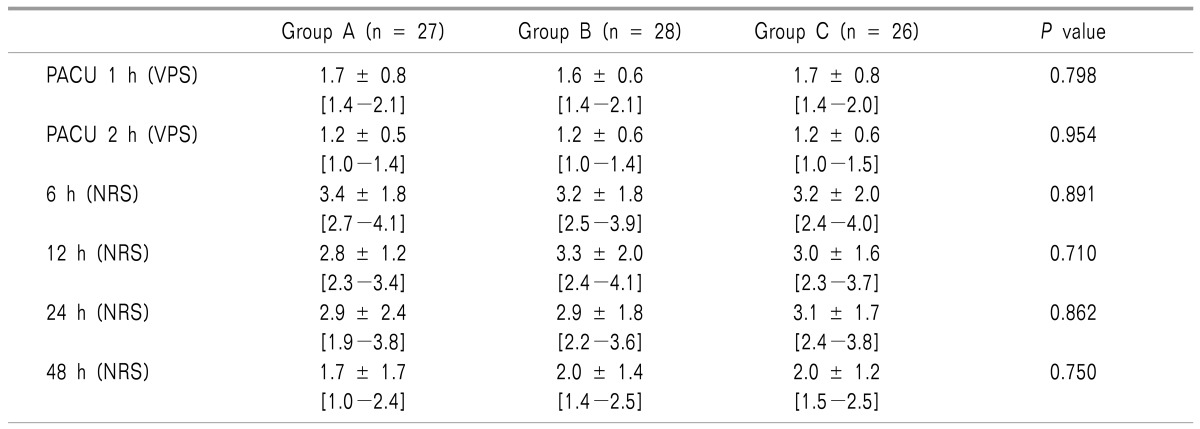1. Dolin SJ, Cashman JN, Bland JM. Effectiveness of acute postoperative pain management: I. Evidence from published data. Br J Anaesth. 2002; 89:409–423. PMID:
12402719.

2. Sidebotham D, Dijkhuizen MR, Schug SA. The safety and utilization of patient-controlled analgesia. J Pain Symptom Manage. 1997; 14:202–209. PMID:
9379067.

3. Chelly JE, Grass J, Houseman TW, Minkowitz H, Pue A. The safety and efficacy of a fentanyl patient-controlled transdermal system for acute postoperative analgesia: a multicenter, placebo-controlled trial. Anesth Analg. 2004; 98:427–433. PMID:
14742382.

4. Friedman Z, Katznelson R, Phillips SR, Zanchetta C, Nistor OI, Eisen LB, et al. A randomized double-blind comparison of a morphine-fentanyl combination vs. morphine alone for patient-controlled analgesia following bowel surgery. Pain Pract. 2008; 8:248–252. PMID:
18503621.

5. Woodhouse A, Ward ME, Mather LE. Intra-subject variability in post-operative patient-controlled analgesia (PCA): is the patient equally satisfied with morphine, pethidine and fentanyl? Pain. 1999; 80:545–553. PMID:
10342416.

6. Ahmad J, Riley R, Sieunarine K. PCA-induced respiratory depression simulating stroke following endoluminal repair of abdominal aortic aneurysm: a case report. J Med Case Rep. 2007; 1:45. PMID:
17623055.

7. Shapiro A, Zohar E, Zaslansky R, Hoppenstein D, Shabat S, Fredman B. The frequency and timing of respiratory depression in 1524 postoperative patients treated with systemic or neuraxial morphine. J Clin Anesth. 2005; 17:537–542. PMID:
16297754.

8. Curry TJ, Jarosch J, Pacholok S. Are direct to consumer advertisments of prescription drugs educational?: comparing 1992 to 2002. J Drug Educ. 2005; 35:217–232. PMID:
16871737.

9. White PF. Multimodal analgesia: its role in preventing postoperative pain. Curr Opin Investig Drugs. 2008; 9:76–82.
10. Kehlet H, Dahl JB. The value of "multimodal" or "balanced analgesia" in postoperative pain treatment. Anesth Analg. 1993; 77:1048–1056. PMID:
8105724.

11. Kim JA, Kim TH, Yang M, Gwak MS, Kim GS, Kim MJ, et al. Is intravenous patient controlled analgesia enough for pain control in patients who underwent thoracoscopy? J Korean Med Sci. 2009; 24:930–935. PMID:
19794994.

12. Maund E, McDaid C, Rice S, Wright K, Jenkins B, Woolacott N. Paracetamol and selective and non-selective nonsteroidal anti-inflammatory drugs for the reduction in morphine-related side-effects after major surgery: a systematic review. Br J Anaesth. 2011; 106:292–297. PMID:
21285082.

13. Alfonsi P, Adam F, Passard A, Guignard B, Sessler DI, Chauvin M. Nefopam, a nonsedative benzoxazocine analgesic, selectively reduces the shivering threshold in unanesthetized subjects. Anesthesiology. 2004; 100:37–43. PMID:
14695722.

14. Podranski T, Bouillon TW, Riva T, Kurz AM, Oehmke MJ. Compartmental pharmacokinetics of nefopam during mild hypothermia. Br J Anaesth. 2012; 108:784–791. PMID:
22331396.

15. Kim KH, Abdi S. Rediscovery of nefopam for the treatment of neuropathic pain. Korean J Pain. 2014; 27:103–111. PMID:
24748937.

16. Verleye M, André N, Heulard I, Gillardin JM. Nefopam blocks voltage-sensitive sodium channels and modulates glutamatergic transmission in rodents. Brain Res. 2004; 1013:249–255. PMID:
15193535.

17. Evans MS, Lysakowski C, Tramèr MR. Nefopam for the prevention of postoperative pain: quantitative systematic review. Br J Anaesth. 2008; 101:610–617. PMID:
18796441.

18. Sunshine A, Laska E. Nefopam and morphine in man. Clin Pharmacol Ther. 1975; 18:530–534. PMID:
1102231.

19. Laboureyras E, Chateauraynaud J, Richebé P, Simonnet G. Long-term pain vulnerability after surgery in rats: prevention by nefopam, an analgesic with antihyperalgesic properties. Anesth Analg. 2009; 109:623–631. PMID:
19608840.

20. Dordoni PL, Della Ventura M, Stefanelli A, Iannace E, Paparella P, Rocca B, et al. Effect of ketorolac, ketoprofen and nefopam on platelet function. Anaesthesia. 1994; 49:1046–1049. PMID:
7864317.

21. Michael R, Younan N, Aziz M, Mostafa N, Ghobriel A, Gintautas J. Effect of a non-opiate analgesic, nefopam hydrochloride, on stress gastric ulcer in rats. Proc West Pharmacol Soc. 2001; 44:109–111. PMID:
11793953.
22. Bhatt AM, Pleuvry BJ, Maddison SE. Respiratory and metabolic effects of oral nefopam in human volunteers. Br J Clin Pharmacol. 1981; 11:209–211. PMID:
6783057.

23. Tirault M, Derrode N, Clevenot D, Rolland D, Fletcher D, Debaene B. The effect of nefopam on morphine overconsumption induced by large-dose remifentanil during propofol anesthesia for major abdominal surgery. Anesth Analg. 2006; 102:110–117. PMID:
16368814.

24. Du Manoir B, Aubrun F, Langlois M, Le Guern ME, Alquier C, Chauvin M, et al. Randomized prospective study of the analgesic effect of nefopam after orthopaedic surgery. Br J Anaesth. 2003; 91:836–841. PMID:
14633755.

25. McLintock TT, Kenny GN, Howie JC, McArdle CS, Lawrie S, Aitken H. Assessment of the analgesic efficacy of nefopam hydrochloride after upper abdominal surgery: a study using patient controlled analgesia. Br J Surg. 1988; 75:779–781. PMID:
3167526.

26. Mimoz O, Incagnoli P, Josse C, Gillon MC, Kuhlman L, Mirand A, et al. Analgesic efficacy and safety of nefopam vs. propacetamol following hepatic resection. Anaesthesia. 2001; 56:520–525. PMID:
11412156.

27. Hamitouche Y, Benhamou D. Postoperative pain relief after gynecologic surgery. J Gynecol Obstet Biol Reprod (Paris). 2004; 33:7–13. PMID:
14968049.
28. Lee JH, Kim JH, Cheong YK. The analgesic effect of nefopam with fentanyl at the end of laparoscopic cholecystectomy. Korean J Pain. 2013; 26:361–367. PMID:
24156002.

29. Kim K, Kim WJ, Choi DK, Lee YK, Choi IC, Sim JY. The analgesic efficacy and safety of nefopam in patient-controlled analgesia after cardiac surgery: a randomized, double-blind, prospective study. J Int Med Res. 2014; 42:684–692. PMID:
24691459.

30. Elia N, Lysakowski C, Tramèr MR. Does multimodal analgesia with acetaminophen, nonsteroidal antiinflammatory drugs, or selective cyclooxygenase-2 inhibitors and patient-controlled analgesia morphine offer advantages over morphine alone? Meta-analyses of randomized trials. Anesthesiology. 2005; 103:1296–1304. PMID:
16306743.

31. Elia N, Tramèr MR. Ketamine and postoperative pain--a quantitative systematic review of randomised trials. Pain. 2005; 113:61–70. PMID:
15621365.

32. Remy C, Marret E, Bonnet F. Effects of acetaminophen on morphine side-effects and consumption after major surgery: meta-analysis of randomized controlled trials. Br J Anaesth. 2005; 94:505–513. PMID:
15681586.

33. Delage N, Maaliki H, Beloeil H, Benhamou D, Mazoit JX. Median effective dose (ED50) of nefopam and ketoprofen in postoperative patients: a study of interaction using sequential analysis and isobolographic analysis. Anesthesiology. 2005; 102:1211–1216. PMID:
15915035.

34. Taniguchi Y, Ali SZ, Kimberger O, Zmoos S, Lauber R, Markstaller M, et al. The effects of nefopam on the gain and maximum intensity of shivering in healthy volunteers. Anesth Analg. 2010; 111:409–414. PMID:
20529984.

35. Beloeil H, Delage N, Nègre I, Mazoit JX, Benhamou D. The median effective dose of nefopam and morphine administered intravenously for postoperative pain after minor surgery: a prospective randomized double-blinded isobolographic study of their analgesic action. Anesth Analg. 2004; 98:395–400. PMID:
14742377.

36. Durrieu G, Olivier P, Bagheri H, Montastruc JL. French Network of Pharmacovigilance Centers. Overview of adverse reactions to nefopam: an analysis of the French Pharmacovigilance database. Fundam Clin Pharmacol. 2007; 21:555–558. PMID:
17868209.

37. Tigerstedt I, Tammisto T, Leander P. Comparison of the analgesic dose-effect relationships of nefopam and oxycodone in postoperative pain. Acta Anaesthesiol Scand. 1979; 23:555–560. PMID:
397711.









 PDF
PDF Citation
Citation Print
Print




 XML Download
XML Download